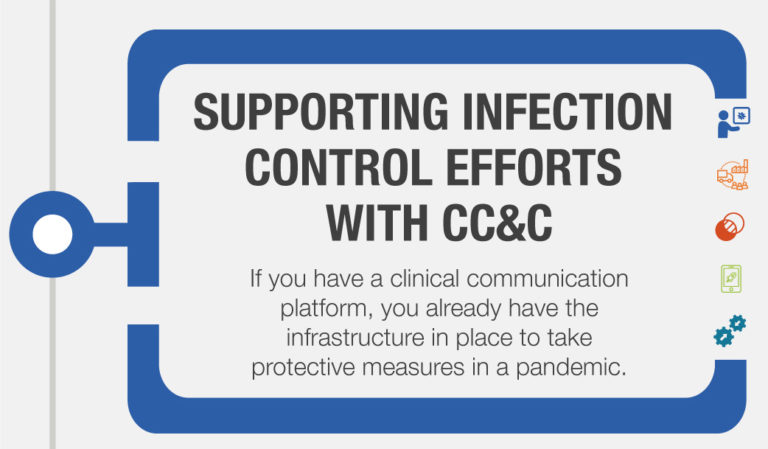Infection control is always a priority for healthcare organizations, but now more than ever it has taken center stage. It can be tricky to coordinate a strong line of defense—at an organizational level—for infection control purposes. But if you have a clinical communication platform, you already have the infrastructure in place to take protective measures in a pandemic.
1. Connect Your Infection Control Lead
You may be preparing to deploy, or have already deployed, your Incident Command Center. If you’ve created a virtual instance of the ICC within your clinical communication and collaboration (CC&C) platform, you can designate your Infection Control Lead to make them identifiable to the rest of the organization. This also ensures that all of the necessary leaders for enabling infection control have the tools in place to reach and be reached by any colleague.
2. Loop in the Supply Chain Team
Supply chain is not always the first consideration when it comes to reducing exposure to a virus, but strategizing around supply chain is key to limiting rate of infection. When the supply chain team, including and especially the sanitization crew, is involved in infection control strategy and execution from the start, it closes common communication gaps and keeps everyone safer.
A great way to loop them in is to onboard them to your CC&C platform, so that they can communicate seamlessly with leadership and with clinicians looking to utilize protective equipment.
3. Communicate Transparently
In fact, communicating standards and supply updates across your organization will be critical to the success of an infection control initiative. Make sure you’re keeping all of your frontline staff aware of any timely updates by leveraging one-to-many broadcasting capabilities or even global messaging to reach colleagues across multiple facilities.
These updates should include information like personal protective equipment shipments and distribution plans, number of confirmed cases, and even any staff shortages you may be facing. Closing the loop on enterprise-wide communications can ensure staff safety and reduce risk of infection just by virtue of having the most up-to-date information available.
4. Educate Your Frontline Staff
While many of your organization’s employees are patient-facing, they likely have not experienced the level of necessary care around infection control that the coronavirus pandemic commands. Despite efforts to make resources, such as training videos, reference documents and websites, available to the frontline staff who need them most, it’s not easy to distribute these materials in the traditional ways. Your infection control team likely doesn’t have the time to be hanging flyers or hosting training sessions, which is why your organization needs to find another way to make these assets available.
Your CC&C platform should have the ability to add these videos, documents and links as a launchable point in the end user’s dashboard, so that they can review proper PPE donning techniques or common symptoms of COVID-19 as they need to.
5. Leverage Existing Integrations
Many healthcare organizations are concerned right now about the state of interoperability. More than ever before, now is the time when all existing systems in the hospital infrastructure need to integrate seamlessly. This should go for your CC&C platform as well, and you can approach these integrations in a strategic way in order to minimize risk of exposure.
Work with your vendor to identify the opportunities for flexibility. Remote monitoring capabilities and nurse call are two common systems that can integrate with your clinical communications in order to limit exposure and save PPE. Anything that can foster virtual communication and collaboration will make a positive contribution.
Trying to control the rate of infection during a pandemic like coronavirus can seem a bit fruitless. But by approaching your infection control strategy from the angle of protective communications, there are a lot of proactive steps your organization can take to provide clear guidance. If you have any questions about how to specifically implement some of these tips contact us at covid19@mobileheartbeat.com.



